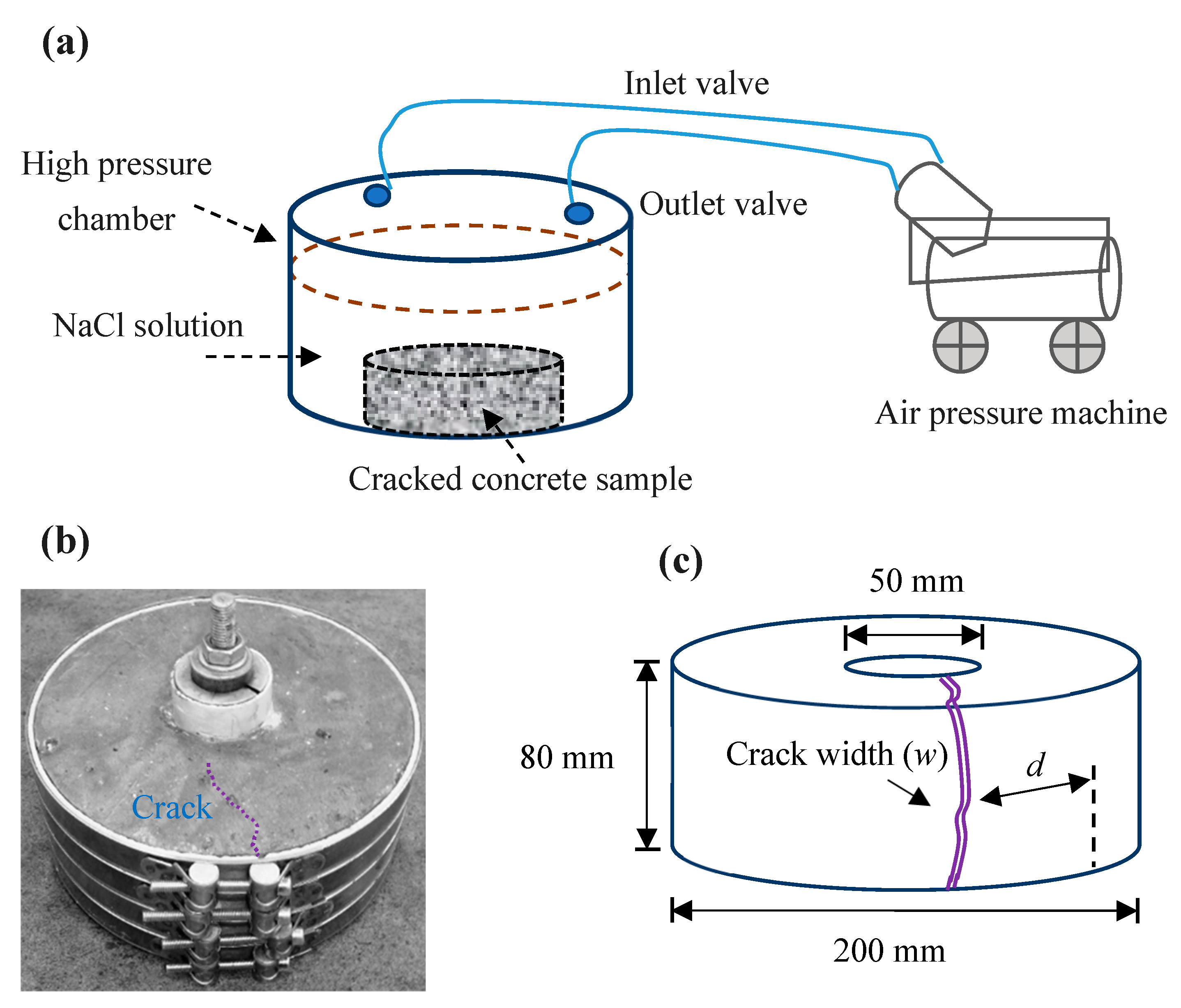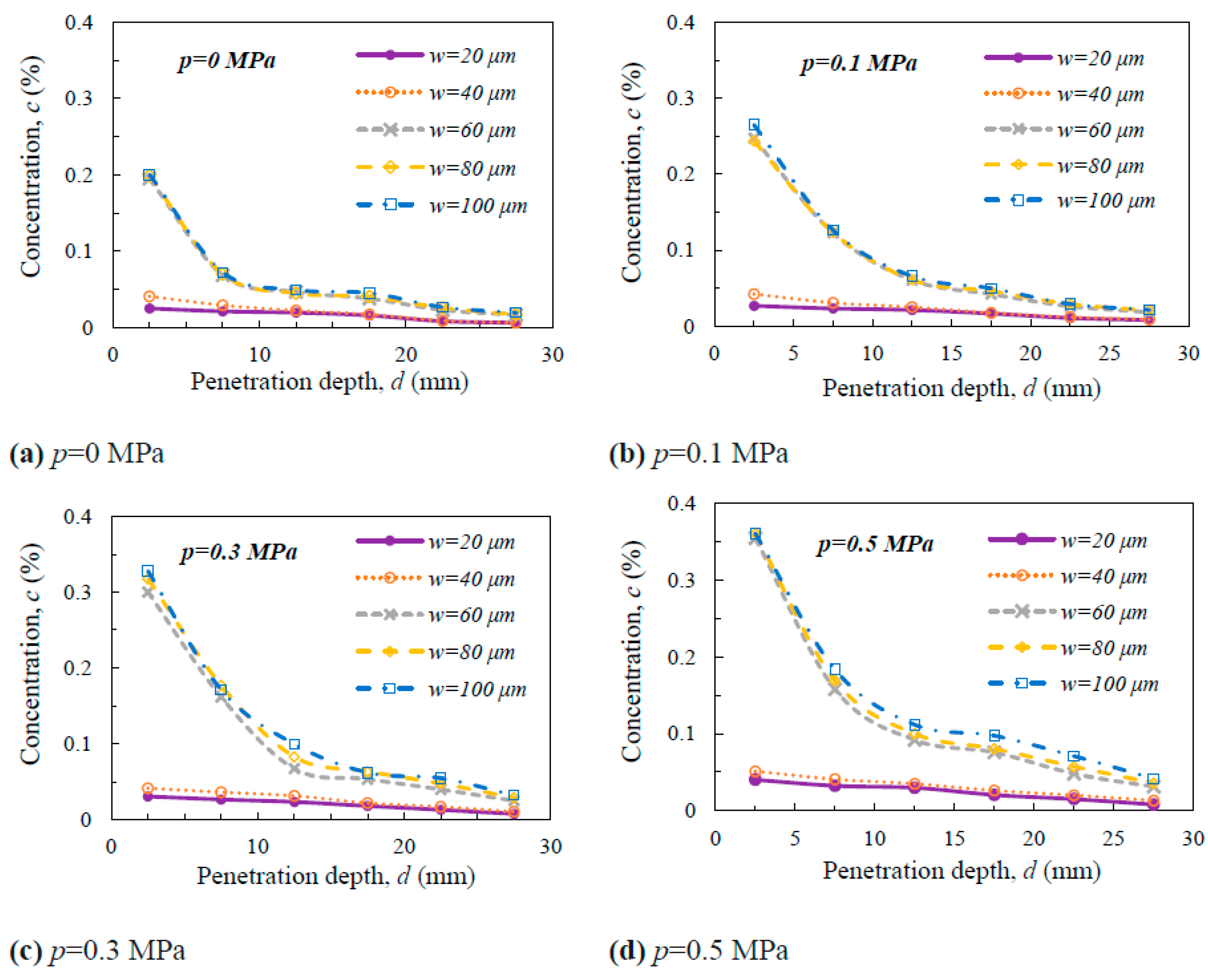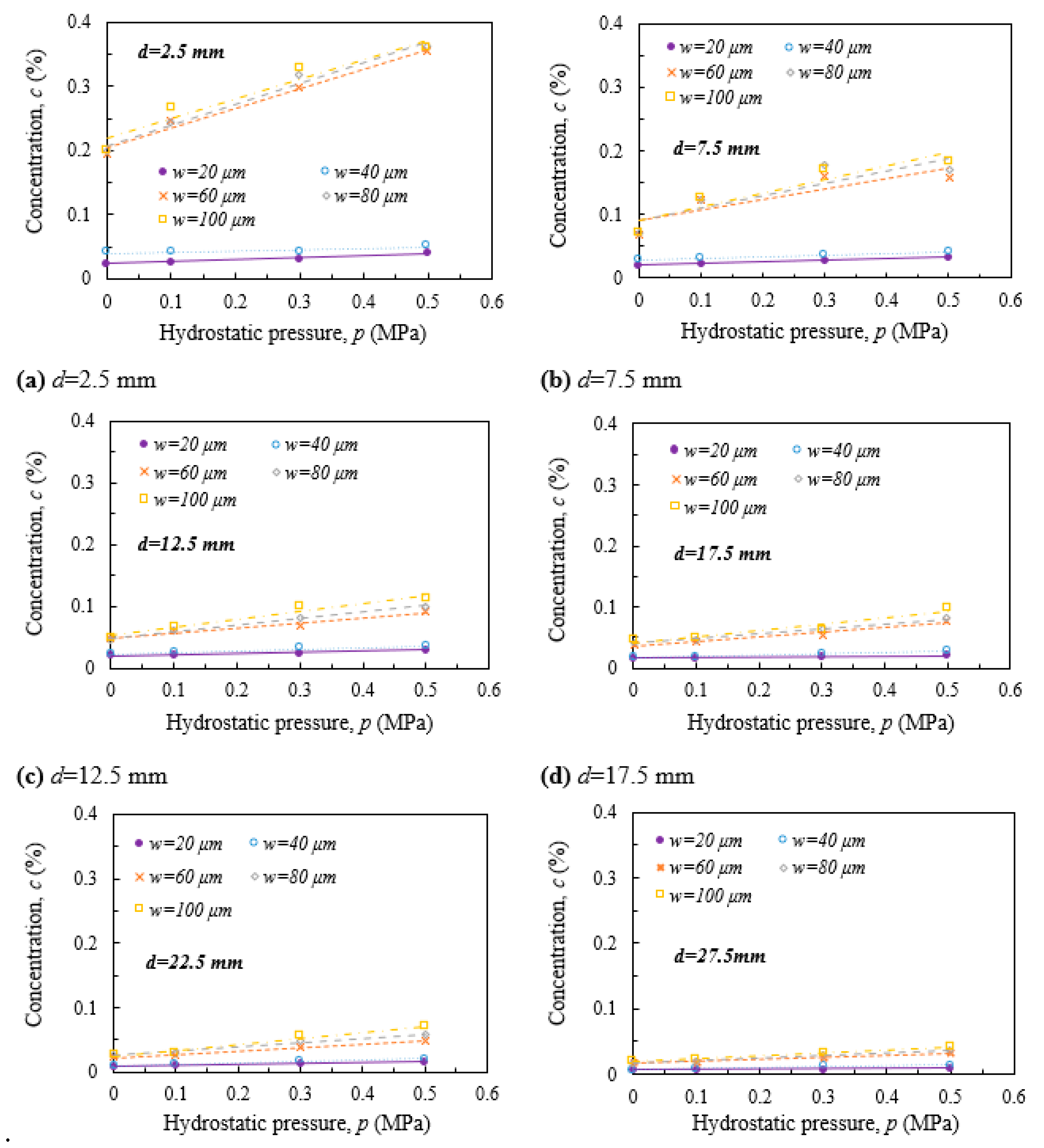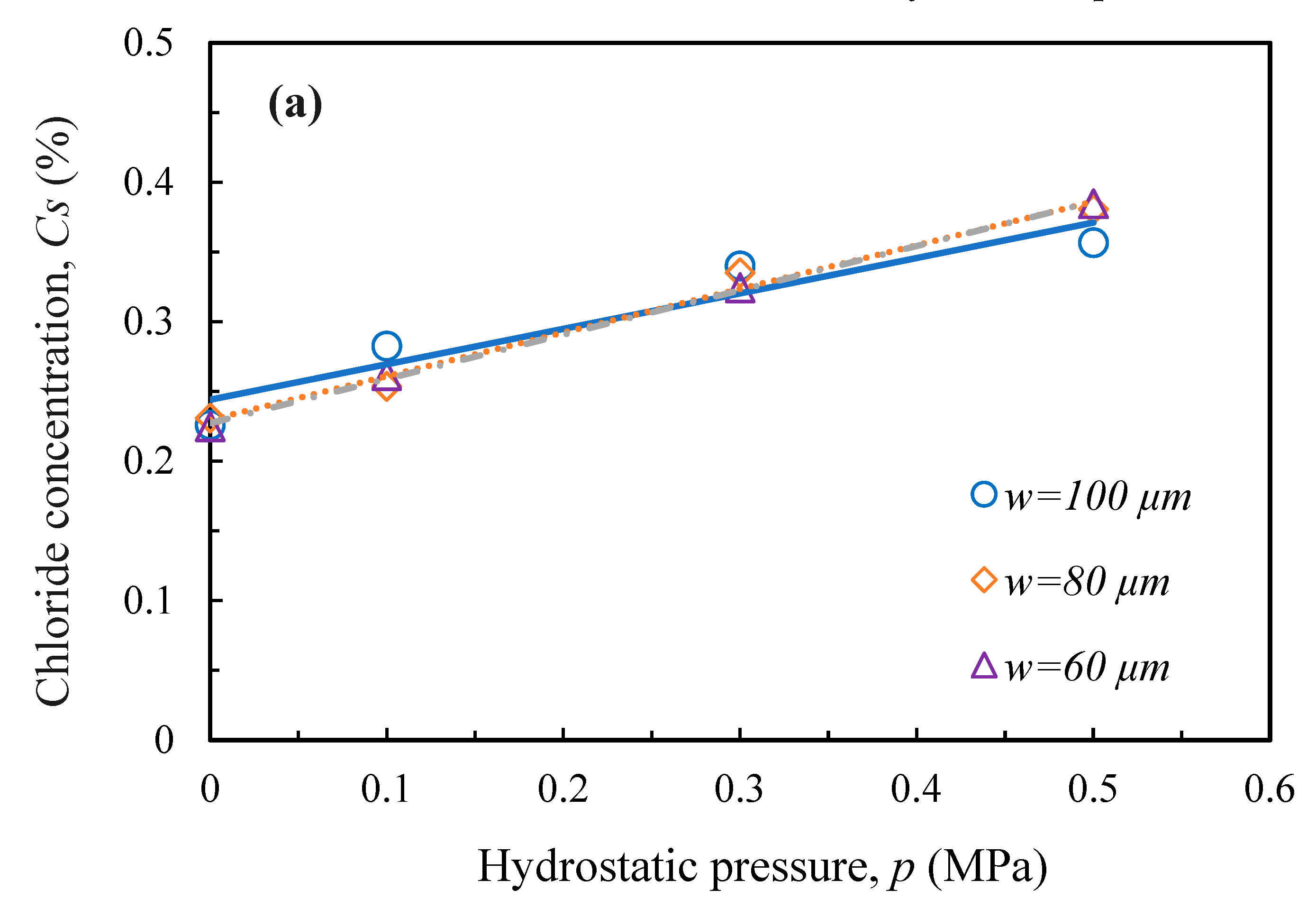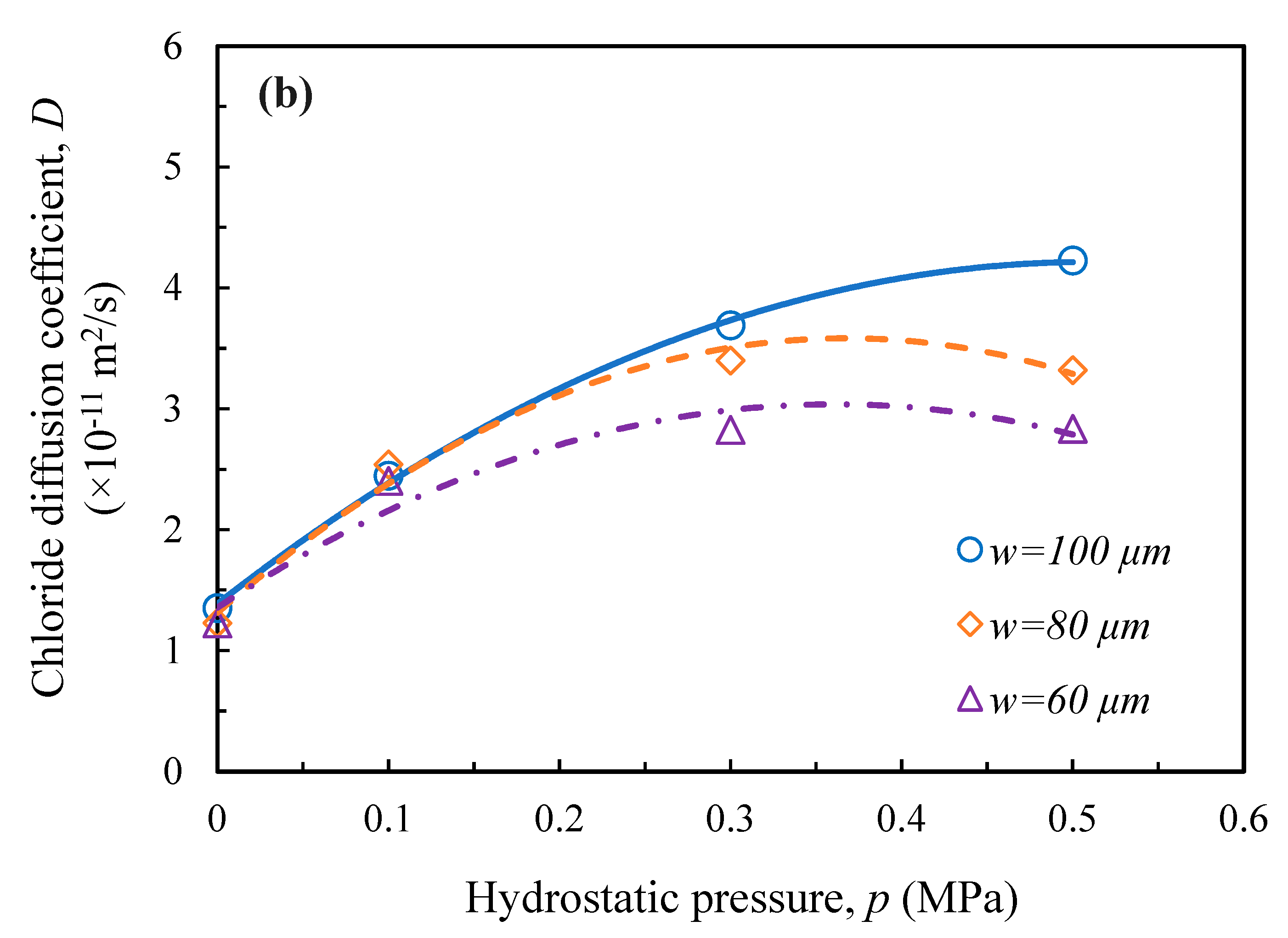1. Introduction
The performance of reinforced concrete structures built and served in marine environments are often degraded due to chloride-induced corrosion. Chloride ion penetration into concrete depends on a number of variables, such as chloride ion concentration, concrete’s microstructures and properties, and the magnitude of hydrostatic pressure [
1,
2,
3]. On the one hand, concrete structures are unavoidably cracked due to internal deformation and external loadings during service life. The presence of cracks in the concrete accelerates the corrosion process of the steel reinforcement. On the other hand, water pressure affects substantially the chloride penetration process into concrete with cracks whose hydraulic properties are heavily stress dependent. Therefore, understanding the behaviour of chloride diffusion in concrete with cracks under various hydrostatic pressure is critical to assess and predict the long-term durability of marine engineering concrete structures, particularly for those in the deep-sea environments [
4,
5].
The effect of cracks on the chloride penetration of concrete has attracted numerous investigations recently [
6,
7,
8,
9,
10,
11,
12,
13,
14,
15]. Aldea et al. [
14] reported that the chloride permeability increased with increased crack widths and the water permeability was much more sensitive than that of chlorides. Olga and Hooton [
16] however reported that chloride diffusion was independent of both crack width and crack wall roughness. François et al. [
17] reported that the chloride diffusion perpendicular to the crack walls with wide cracks (width ≥205 μm) was similar to that of the surface. For the cracks ran through the specimens, the diffusion coefficient in the crack in steady-state conditions was assumed to equal the diffusion coefficient in free solution [
7,
8]. Therefore, it is apparent that cracks in concrete greatly affect the durability of reinforced concrete structures with some inconsistent findings in previous literature. Liu et al. [
18,
19,
20,
21] studied the migration mechanism of chloride in cracked concrete by numerical simulation, which provided a new idea for the durability design of concrete. In theory, stability of deep-sea concrete-made engineering infrastructures is closely associated with the concrete durability under a high hydrostatic pressure environment. However, the effect of hydrostatic pressure on the penetration of chloride in cracked concrete has been rarely explored.
This paper reports experimental studies on chloride diffusion in the pre-cracked concrete under different degrees of hydrostatic pressure. The crack of a desired width in the concrete specimen was manually created using a controlled splitting tensile apparatus and maintained during the chloride penetration process in cracked concrete. The average crack width varied from 20 μm to about 100 μm. Moreover, the effect of hydrostatic pressure on the diffusion coefficient values of the cracked concrete was examined.
2. Experimental study
2.1. Sample preparation
Figure 1 illustrates the experimental configuration for exploring the chloride transport into the cracked concrete samples under various magnitudes of hydrostatic pressure. An air pressure machine was employed to apply four different hydrostatic pressures of 0MPa, 0.1MPa, 0.3MPa and 0.5MPa on the cracked concrete, and the highest hydrostatic pressure simulated the marine environment in depth up to 50m. The concrete specimen exhibited a ring profile with an inner radius of 50 mm, outer radius of 200 mm, and height of 80 mm (
Figure 1b). The concrete mixture consisted of cement, water, sand, aggregates, and water reduction agent in the ratio of 1:0.38:1.56:2.66:0.012, which complied with the Chinese Standard, JGJ55-2000 [
22]. The cement type was P.II 52.5, with an apparent density of 3150 kg/m
3. The aggregate size ranged from 5 mm to 20 mm with continuous grading, and its apparent density was 2630 kg/m
3. The apparent density of sand was 2.64 g/cm
3 with a water proportion of 3.7%. The type of the water reducing agent was HP4000A with a water reduction ratio of 27.5%. The uniaxial compressive strength of the concrete was 50.5 MPa and 59.1 MPa after 14 and 28 days curing, respectively. The tensile strength of the concrete was respectively 5.36 MPa and 6.87 MPa after 14 and 28 days. Twenty concrete samples were prepared from a single batch for the concrete mixtures after 14 and 28 days curing, respectively. The concrete mixtures were cast in steel molds and compacted using a mechanical vibrator.
2.2. Sample pre-cracking
Cracks with five different widths of 20μm, 40μm, 60μm, 80μm and 100μm in the ring concrete sample was created by a controlled splitting tensile apparatus. A crack width gauge, DJCK-2 Type, was used to measure the crack width. After cutting, the lateral surfaces of ring concrete sample were sealed with two epoxy resin coats to ensure chloride flow through the ring concrete crack in the radial direction (
Figure 1c).
3. Results and analysis
3.1. Chloride concentration quantification
The chloride concentration in concrete is estimated through the Volhard method. The powdered concrete samples normal to the crack surface are used to extract acid-soluble chloride contents [
23], as shown in
Figure 1c. The chloride diffusion is calculated by fitting the experimentally-measured curves. The penetration of chloride into concrete is assumed one-dimensional in a semi-infinite medium complying with Fick’s second law of pure diffusion [
24]:
Solve Eq. (1):
where
is the chloride concentration at distance
x from the exposed surface,
is the surface chloride concentration,
is the apparent chloride diffusion coefficient,
is the exposure time, and
is the error function [
24]. The values of
and
are determined from fitting the measured chloride profile.
3.2. Effect of crack width on chloride diffusion
Figure 2 shows the chloride concentration of the ring concrete sample with different crack width under varying magnitudes of hydrostatic pressure. As the hydrostatic pressure grows from 0 to 0.5 MPa, remarkable difference in chloride concentration (
) occurs between the crack width increases from 20 µm to 40 µm and that from 60 µm to 100 µm. The chloride concentration (
) (0.025% to 0.041%) for the crack width of 20 µm to 40 µm is substantially lower than that of 60 µm to100 µm (0.19% to 0.36%), particularly for those close to the crack. The discrepancy decreases as the penetration depth (
d) from the crack increases. That is to say, the crack width affects remarkably the chloride transport in concrete and the influence degree decreases with the increasing penetration depth. The effect of the crack width is less pronounced when the width is around 20 µm to 40 µm. Similarly, minor difference is found between that of crack width of around 60 µm to 100 µm. Therefore, a critical crack width exists beyond which the chloride transportation in concrete is dramatically influenced. The results are consistent with the studies reported in the literature [
6,
12,
25].
3.3. Effect of hydrostatic pressure on chloride diffusion
Figure 3 shows the effect of hydrostatic pressure on the chloride transport in concrete with different crack width. Appreciable difference can be found between the chloride concentration of crack width from 20 µm to 40 µm and that of crack width from 60 µm to 100 µm. The hydrostatic pressure slightly affects the chloride transport in the concrete with crack width from 20 µm to 40 µm, whereas the chloride concentration in concrete with crack width from 60 µm to 100 µm is strongly affected. The chloride concentration increases as the hydrostatic pressure increase, particularly for the region near the crack. The slope of the curves for the crack width from 20 µm to 40 µm is around 0.01 to 0.03 and increases to around 0.03 to 0.3 for the crack width from 60 µm to 100 µm. The slope approaches the maximum value of 0.3 at the depth of 2.5 cm. The hydrostatic pressure has dramatically effect on the chloride transport in concrete with the crack width from 60 µm to 100 µm. The relationship between chloride concentration and the hydrostatic pressure is linear:
where
is the chloride concentration in concrete,
is the chloride concentration without hydrostatic pressure,
is the curve slope, and
is the hydrostatic pressure.
Table 1 shows the correlation parameters of the linear relationship
3.4. Diffusion coefficient
Figure 4a and
Figure 4b show the calculated apparent chloride diffusion coefficient
and the corresponding surface chloride concentration
based on Eq. (2), respectively. The chloride concentration (
) for the crack width from 60 µm to 100 µm increases linearly with increasing hydrostatic pressure. The value of
at
p=0 MPa equals 0.22 and reaches 0.38 at
p=0.5 MPa. The effect of hydrostatic pressure on the chloride diffusion into concrete is probably due to the increase of the surface chloride concentration (
) in the cracks given the same chloride concentration in solution, which shows the similar trend to that illustrated in
Figure 3. Similarly, the chloride diffusion coefficient (
) initially increases over the increase in hydrostatic pressure, and keeps constant when the hydrostatic pressure exceeds 0.3 MPa, particularly for the crack width ranging from 60 µm to 80 µm. For the crack width of 100 µm,
increases as the hydrostatic pressure rises from 0 to 0.5 MPa. This suggests that the crack width promotes chloride diffusion under high hydrostatic pressure when the value exceeds 0.1 MPa. Both the calculated apparent chloride diffusion coefficient (
Da) and the surface chloride concentration (
Cs) are influenced dramatically by the hydrostatic pressure which results in the trend of chloride diffusion as the hydrostatic pressure varies.
4. Conclusions
This study showed that hydrostatic pressure affected the chloride diffusion in the pre-cracked concrete with different crack widths. The effect of hydrostatic pressure should be considered when estimating the chloride diffusion in cracked concrete and thus the chloride-induced corrosion, by which the service time of the corresponding concrete structure can be accurately predicted, and effective protective actions could be taken. The main conclusions of the study are listed below.
(1) Under the hydrostatic pressure from 0 MPa to 0.5 MPa, chloride concentration in the concrete increased as the crack width increased. The chloride concentration in the concrete exhibited similar trends for the crack width range from 60 µm to 100 µm and for the crack of width from 20 µm to 40 µm, respectively. A critical crack width seemingly exists beyond which the effect of hydrostatic pressure on the chloride diffusion in concrete was significantly enhanced.
(2) For the concrete sample with a crack of width from 20 µm to 100 µm, chloride concentration increased linearly as the hydrostatic pressure ascended, particularly for the crack width ranging from 60 µm to 100 µm. Moreover, the increase of crack width enhances the effect of hydrostatic pressure on chloride diffusion, so the slope of the chloride concentration-hydrostatic pressure curve increased slightly with the increase in the crack width.
(3) The calculated chloride diffusion coefficient and the surface chloride concentration of the cracked samples increased with increasing crack width and hydrostatic pressure.
Acknowledgments
The authors gratefully acknowledge the financial support provided by the Special projects in key areas of Guangdong Province (NO. 2023ZDZX4145) and the National Natural Science Fund of China (No. 42177141).
References
- [1] M.S. Islam, T. Kishi, Proposal of analysis methods based on stagnation of chloride ion in concrete, J. Adv. Concr. Technol. 11 (2013) 374–382. [CrossRef]
- Z. Jin, X. Zhao, T. Zhao, Y. Liu, Corrosion behavior of steel bar and corrosive cracking of concrete induced by magnesium-sulfate-chloride ions, J. Adv. Concr. Technol. 14 (2016) 172–182. [CrossRef]
- R. Wattanapornprom, T. Ishida, Comprehensive Numerical System for Predicting Airborne Chloride Generation and Its Ingress in Concrete under Actual Environmental Conditions, J. Adv. Concr. Technol. 16 (2018) 18–35. [CrossRef]
- C. Fu, X. Jin, H. Ye, N. Jin, Theoretical and experimental investigation of loading effects on chloride diffusion in saturated concrete, J. Adv. Concr. Technol. 13 (2015) 30–43. [CrossRef]
- X.M. Wan, F.H. Wittmann, T.J. Zhao, F.X. Jiang, Chloride penetration into concrete, Key Eng. Mater. 400–402 (2009) 181–186. [CrossRef]
- N. Gowripalan, V. Sirivivatnanon, C.C. Lim, Chloride diffusivity of concrete cracked in flexure, Cem. Concr. Res. 30 (2000). [CrossRef]
- B. Gérard, J. Marchand, Influence of cracking on the diffusion properties of cement-based materials. Part I: Influence of continuous cracks on the steady-state regime, Cem. Concr. Res. 30 (2000). [CrossRef]
- S. Jacobsen, J. Marchand, L. Boisvert, Effect of cracking and healing on chloride transport in OPC concrete, Cem. Concr. Res. 26 (1996). [CrossRef]
- T. Sugiyama, T.W. Bremner, Y. Tsuji, Determination of chloride diffusion coefficient and gas permeability of concrete and their relationship, Cem. Concr. Res. 26 (1996). [CrossRef]
- 10. H.R. Samaha, K.C. Hover, Influence of microcracking on the mass transport properties of concrete, ACI Mater. J. 89 (1992). [CrossRef]
- C.C. Lim, N. Gowripalan, V. Sirivivatnanon, Microcracking and chloride permeability of concrete under uniaxial compression, Cem. Concr. Compos. 22 (2000). [CrossRef]
- A. Djerbi, S. Bonnet, A. Khelidj, V. Baroghel-bouny, Influence of traversing crack on chloride diffusion into concrete, Cem. Concr. Res. 38 (2008). [CrossRef]
- M.B. Otieno, M.G. Alexander, H.D. Beushausen, Corrosion in cracked and uncracked concrete - influence of crack width, concrete quality and crack reopening, Mag. Concr. Res. 62 (2010). [CrossRef]
- C.-M. Aldea, S.P. Shah, A. Karr, Effect of Cracking on Water and Chloride Permeability of Concrete, J. Mater. Civ. Eng. 11 (1999). [CrossRef]
- 15. M. Saito, H. Ishimori, Chloride permeability of concrete under static and repeated compressive loading, Cem. Concr. Res. 25 (1995). [CrossRef]
- Rodriguez, R.D. Hooton, Influence of cracks on chloride ingress into concrete, ACI Mater. J. 100 (2003). [CrossRef]
- 17. M. Ismail, A. Toumi, R. François, R. Gagné, Effect of crack opening on the local diffusion of chloride in cracked mortar samples, Cem. Concr. Res. 38 (2008) 1106–1111. [CrossRef]
- Q. feng Liu, M.F. Iqbal, J. Yang, X. yang Lu, P. Zhang, M. Rauf, Prediction of chloride diffusivity in concrete using artificial neural network: Modelling and performance evaluation, Constr. Build. Mater. 268 (2021) 121082. [CrossRef]
- 19. L. jie Li, Q. feng Liu, L. Tang, Z. Hu, Y. Wen, P. Zhang, Chloride penetration in freeze–thaw induced cracking concrete: A numerical study, Constr. Build. Mater. 302 (2021). [CrossRef]
- C. lin Zhang, W. kang Chen, S. Mu, B. Šavija, Q. feng Liu, Numerical investigation of external sulfate attack and its effect on chloride binding and diffusion in concrete, Constr. Build. Mater. 285 (2021) 122806. [CrossRef]
- Q.F. Liu, J. Yang, J. Xia, D. Easterbrook, L.Y. Li, X.Y. Lu, A numerical study on chloride migration in cracked concrete using multi-component ionic transport models, Comput. Mater. Sci. 99 (2015) 396–416. [CrossRef]
- 22. Ministry of construction of the people’s Republic of China, JGJ 55-2000, Mix proportion design of ordinary concrete, China Building Industry Press, Beijing, (2000).
- 23. S. Etris, Y. Fiorini, K. Lieb, I. Moore, A. Batik, H. Berman, Determination of Low Levels of Chloride in Hardened Portland Cement Paste, Mortar, and Concrete, J. Test. Eval. 3 (1975). [CrossRef]
- J. Crank, The mathematics of diffusion, Second Edition, Oxford Univ. Press. (1975).
- L. Marsavina, K. Audenaert, G. De Schutter, N. Faur, D. Marsavina, Experimental and numerical determination of the chloride penetration in cracked concrete, Constr. Build. Mater. 23 (2009). [CrossRef]
|
Disclaimer/Publisher’s Note: The statements, opinions and data contained in all publications are solely those of the individual author(s) and contributor(s) and not of MDPI and/or the editor(s). MDPI and/or the editor(s) disclaim responsibility for any injury to people or property resulting from any ideas, methods, instructions or products referred to in the content. |
© 2023 by the authors. Licensee MDPI, Basel, Switzerland. This article is an open access article distributed under the terms and conditions of the Creative Commons Attribution (CC BY) license (http://creativecommons.org/licenses/by/4.0/).
